Kitchen Island Lighting: The Best Way to Light Up Your Dream Kitchen
Are you sick of cooking in the dark or not being able to see what you’re chopping on your kitchen island?”Kitchen island lighting” isn’t just about how bright it is. It’s also about making the right mood and making sure you can work safely and well. This complete guide will help you pick, install, and style the best lighting for your kitchen, whether you’re completely remodelling it or just updating the lights.
We’ll look at all kinds of lighting options in this guide, from pendant lights and chandeliers to kitchen under-cabinet lighting. You’ll find more than 25 beautiful design ideas, learn about the different types of fixtures, and get expert advice on how to put them up. You’ll have all the information you need to turn your kitchen into a well-lit, useful workspace by the end.
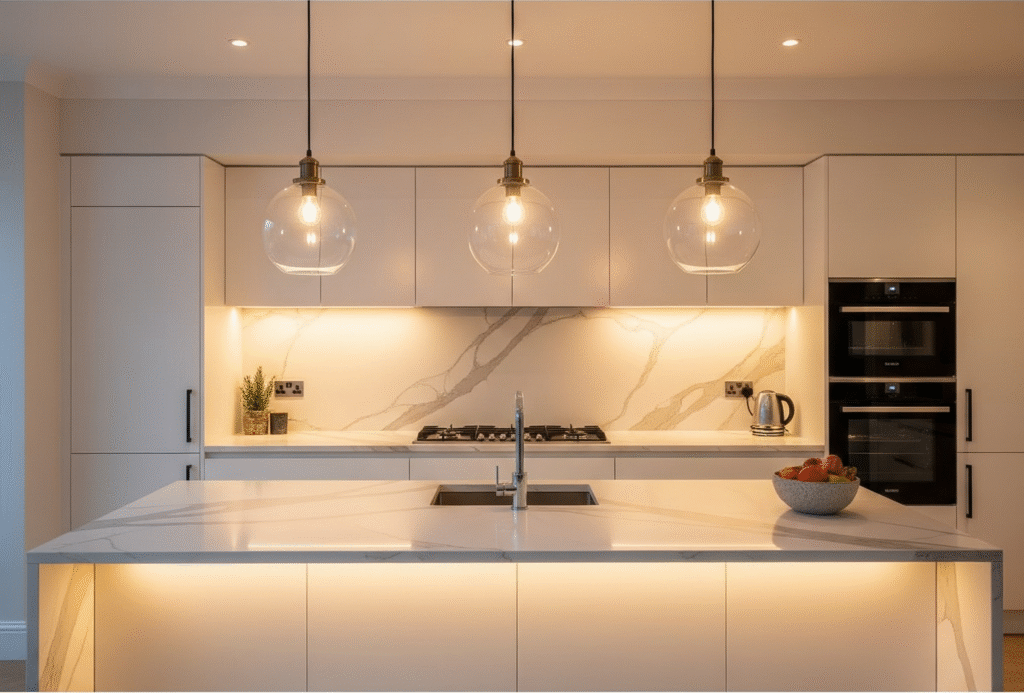
Why You Should Care More About Kitchen Island Lighting
Your kitchen island is a prep area, a place to eat, a place to do homework, and a place to hang out with friends all in one. That’s why it’s so important to get the lighting just right. Bad lighting can make cooking dangerous, make your dinner parties look bad, and make your beautiful island look dull and uninviting.
Kitchen island lighting can change the value of your home when you sell it and how you cook every day. Researchers have found that kitchens with good lighting can raise property values by up to 10%, and kitchens with the right task lighting can lower accidents by almost 40%. When you use both overhead island lighting and well-placed under-cabinet lighting, you create layers of light that make your kitchen look great and work really well.
The most important thing is to know that one size doesn’t work for everyone. A big island for the whole family needs different lighting than a small breakfast bar. If your island also serves as a dining area, you’ll want dimmable lights that can go from bright task lighting while you prepare food to warm ambient lighting while you eat.
Tip Box: Quick Check of the Lighting
Stand in your kitchen at different times of the day and see where the shadows fall on your island. If you feel like you’re cooking in a dark or cramped space, you should add more light.
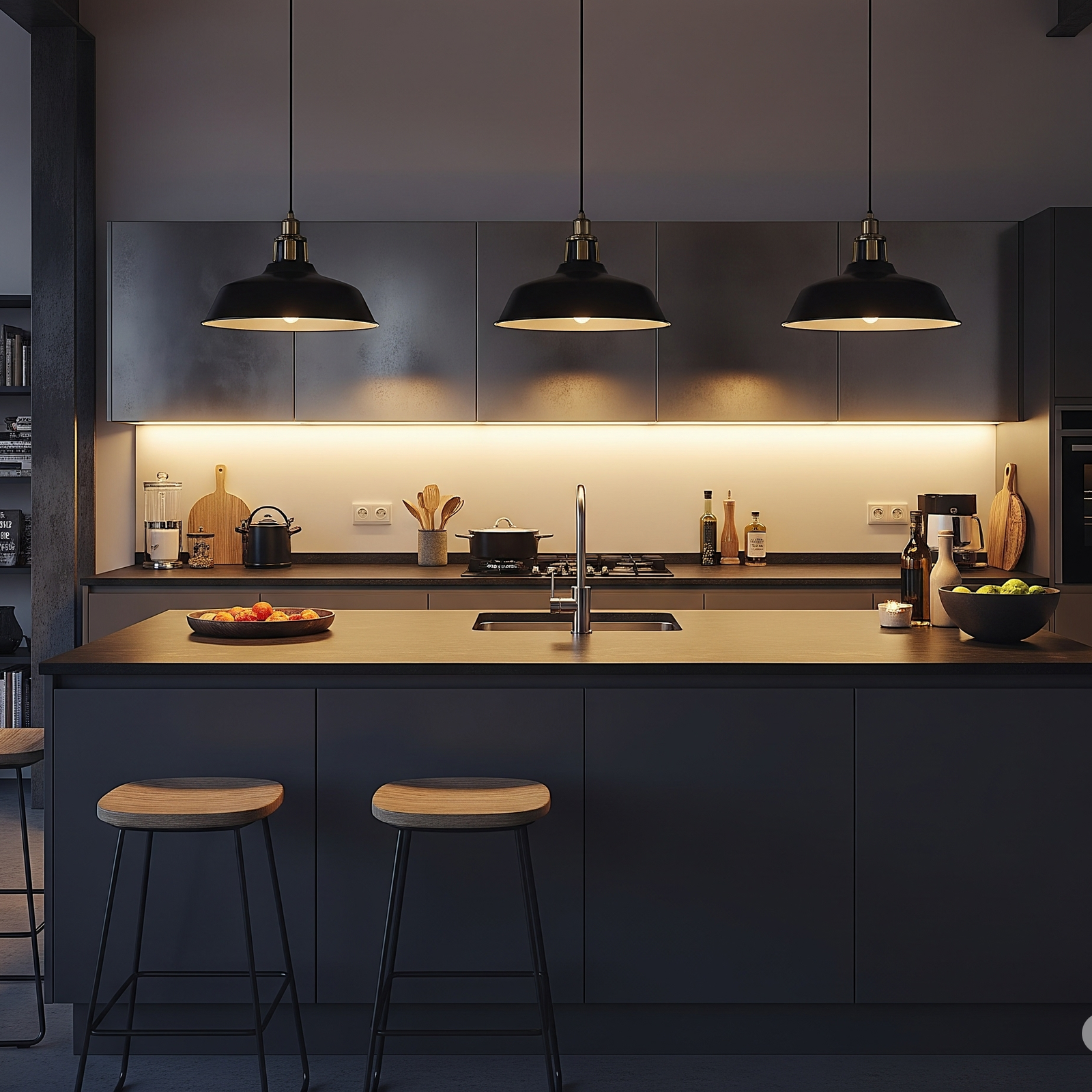
Different Types of Kitchen Island Lighting: How to Find the Right One for You
Pendant Lights: The Old-Fashioned Choice
For good reason, pendant lights are still the most popular choice for kitchen island lighting. They give you focused light down where you need it most, and they also add style and interest to your space.
If your island is 6 feet or longer, plan on using 2–3 pendant lights that are 24–30 inches apart. One or two pendants usually look best on smaller islands (4–5 feet). Put them 30 to 36 inches above the island surface.
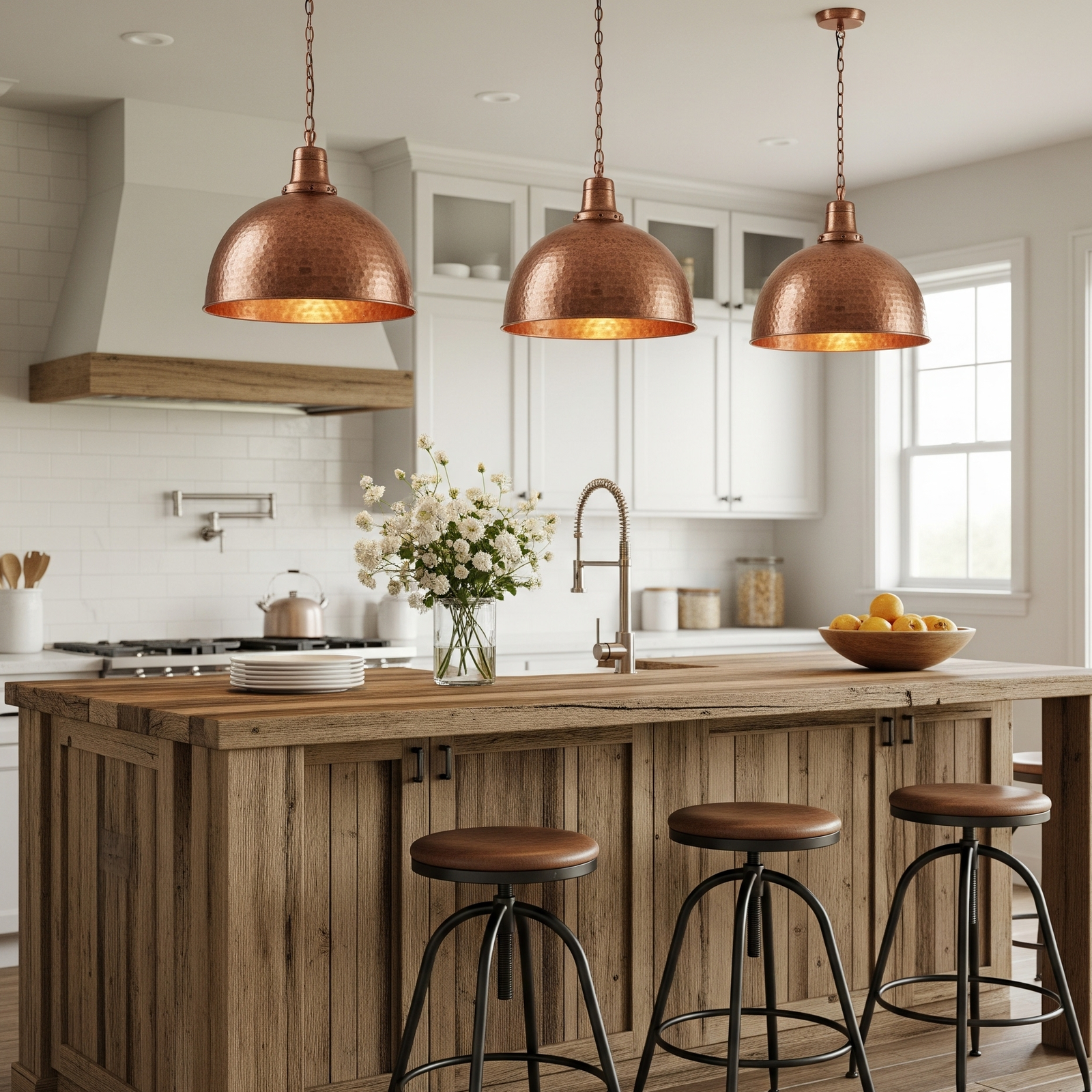
Linear Chandeliers: Making a Statement
Linear chandeliers are the best way to make your kitchen island lighting stand out. These long lights work best over big islands (8 feet or more) or in kitchens with high ceilings. They spread light evenly while also making a strong visual impact.
A lot of modern linear chandeliers have a lot of bulbs arranged in geometric patterns. Traditional ones might have crystal or wrought iron details.
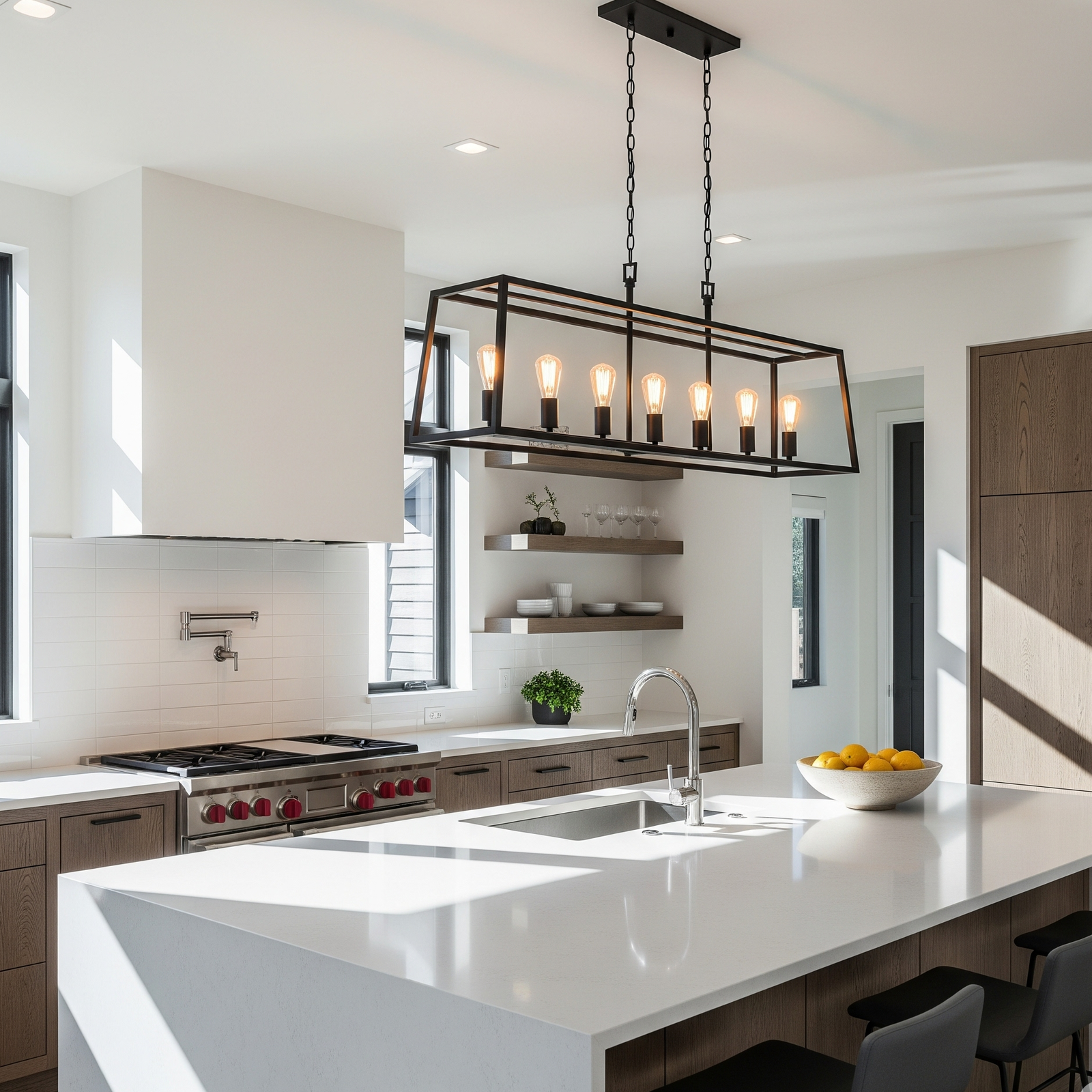
Track and Rail Lighting: The Most Flexible Option
Track and rail systems are the best way to set up your kitchen island lighting because they give you the most options. These systems let you put each light head exactly where you want it, which makes them great for islands with more than one work area or strange shapes.
The track lighting of today is very different from the simple lights of the past. You can choose from sleek LED heads, decorative pendant attachments, and even smart controls that let you change the brightness of each light with your phone.
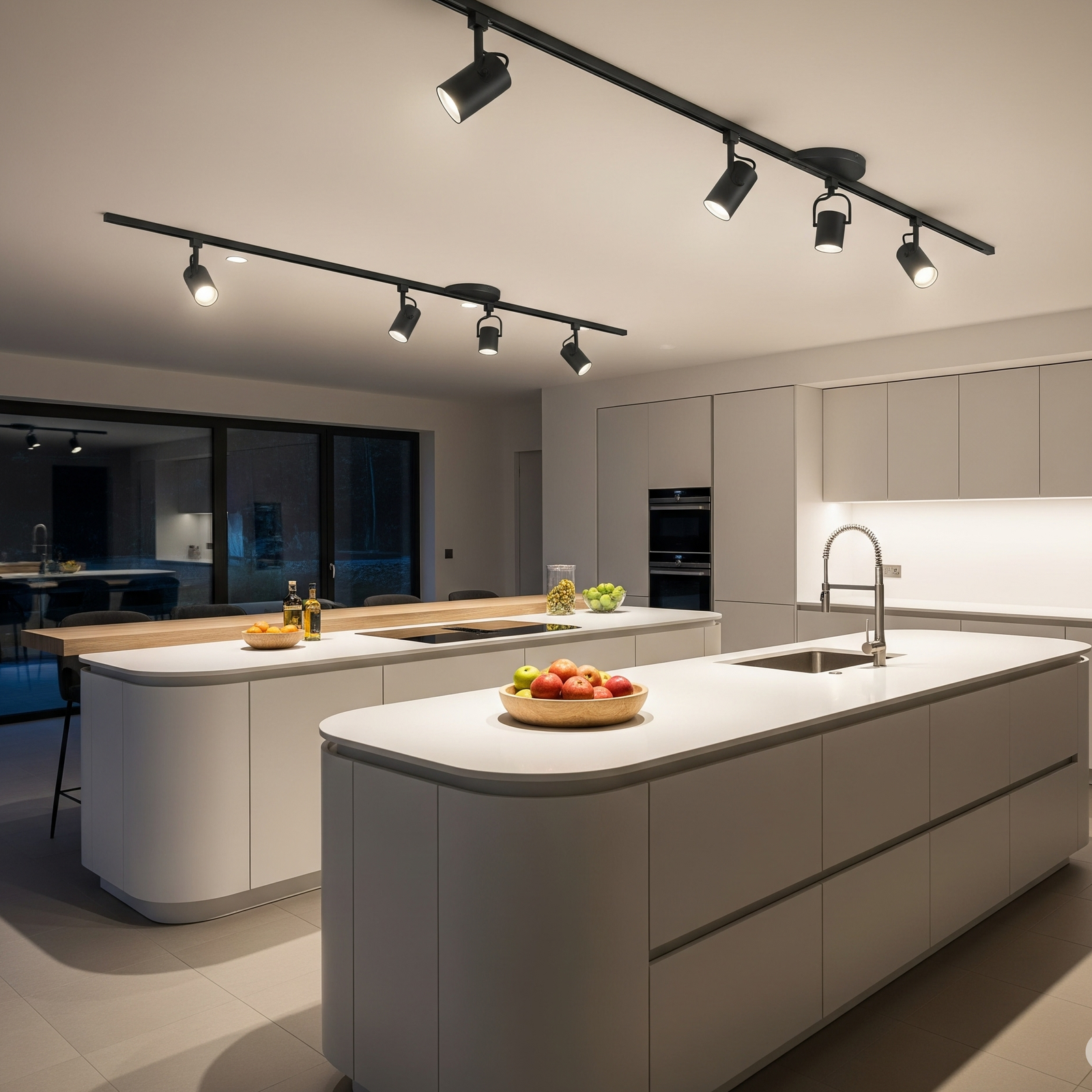
Kitchen under-cabinet lighting is the game-changing addition.
Why It’s Important to Have Under-Cabinet Lighting
Kitchen under-cabinet lighting may seem like a luxury, but it’s one of the best improvements you can make. These lights get rid of shadows from overhead lights, which makes cooking safer and more fun. They also add useful ambient light that makes your kitchen feel cozy and inviting..
The best part is Installing under-cabinet lighting in the kitchen is now much easier thanks to battery-operated and plug-in options.
Quote Box: Expert Opinion
“Under-cabinet lighting is the secret ingredient that takes a good kitchen design and makes it great. It’s the difference between a kitchen that looks beautiful in photos and one that’s actually beautiful to live in.” – Sarah Martinez, Kitchen Designer
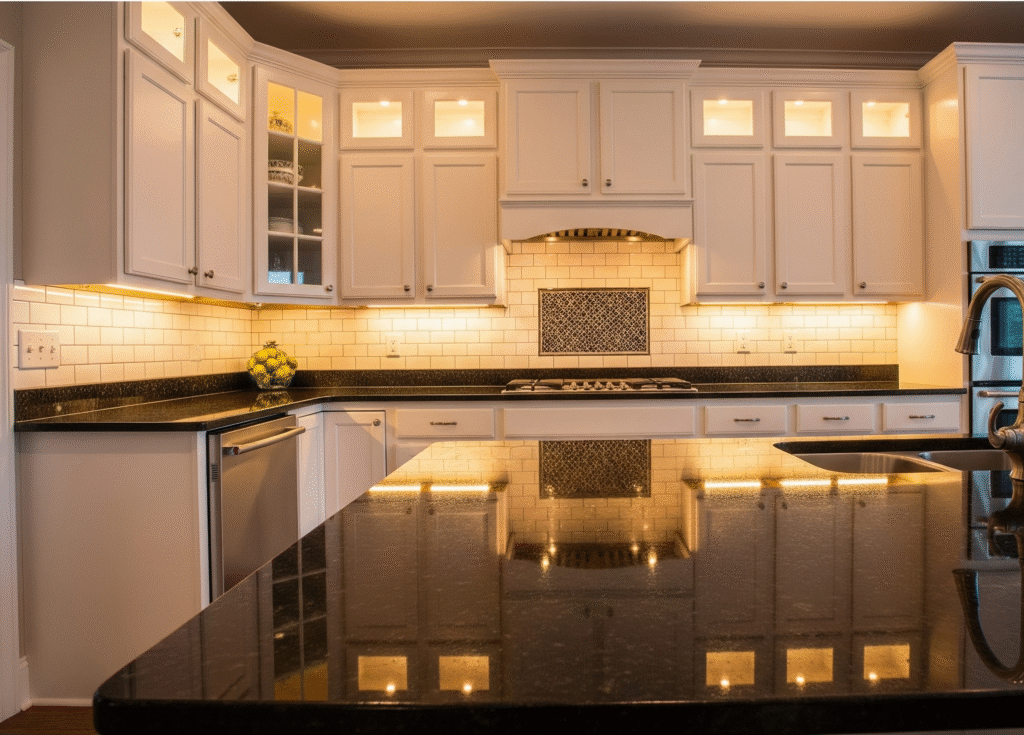
LED Strip Lights: No seams and save energy
The most common type of kitchen under-cabinet lighting is LED strip lights because they give off even, steady light without showing bulbs or fixtures. LED strips that are new are very thin and can be completely hidden under your cabinets, giving your space a clean, smooth look.
High-quality LED strips come in a range of color temperatures, from warm white (2700K) for a cozy atmosphere to daylight white (5000K) for precise work.
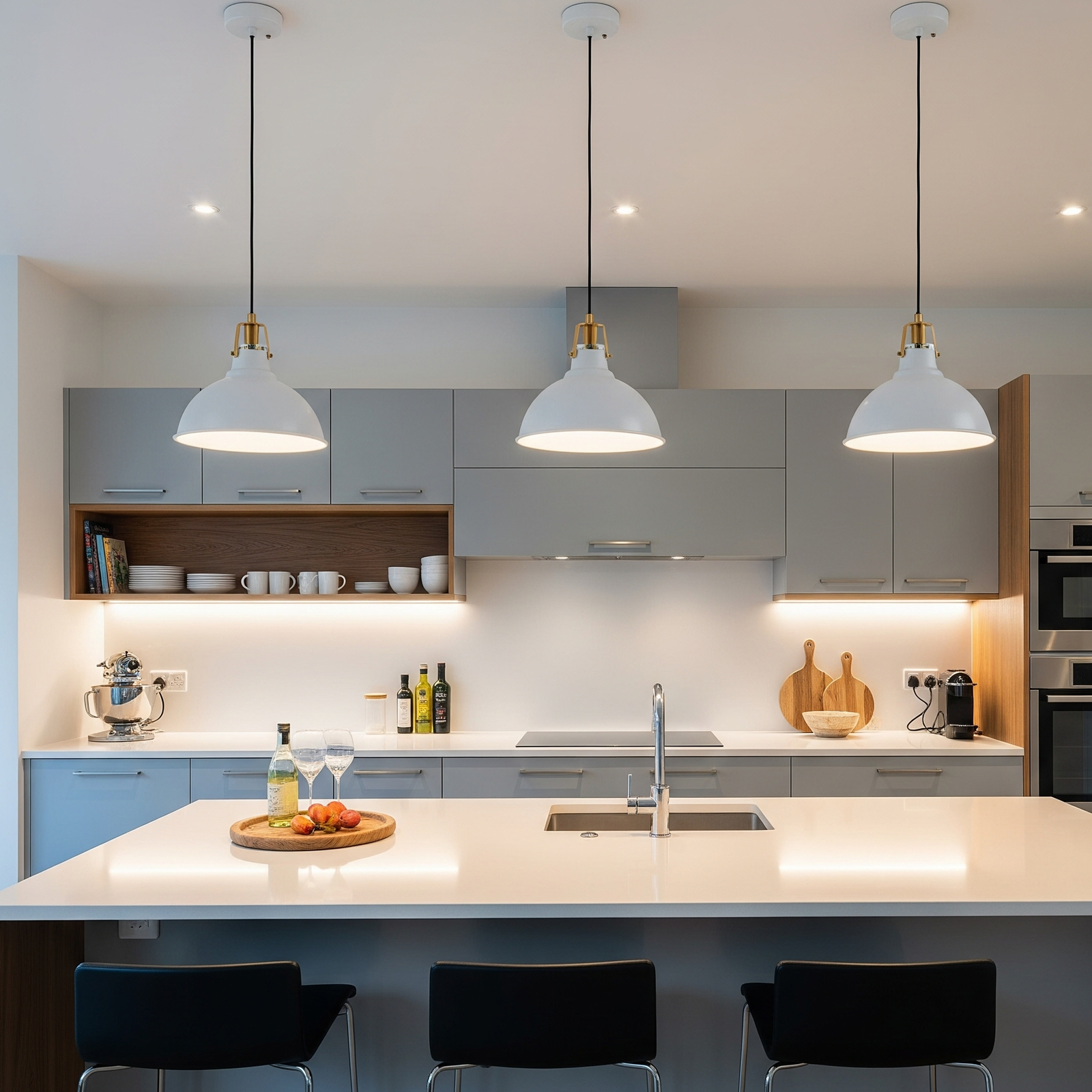
Puck lights are lights that focus on a specific task.
Puck lights give off more focused light than strip lights, so they’re great for places where you need to do a specific task, like coffee stations or prep sinks. You can mount these small, round lights on the surface or inside the wall for a cleaner look.
Puck lights that run on batteries are great for people who rent or don’t want to do electrical work. A lot of them now have motion sensors or touch controls to make things easier.
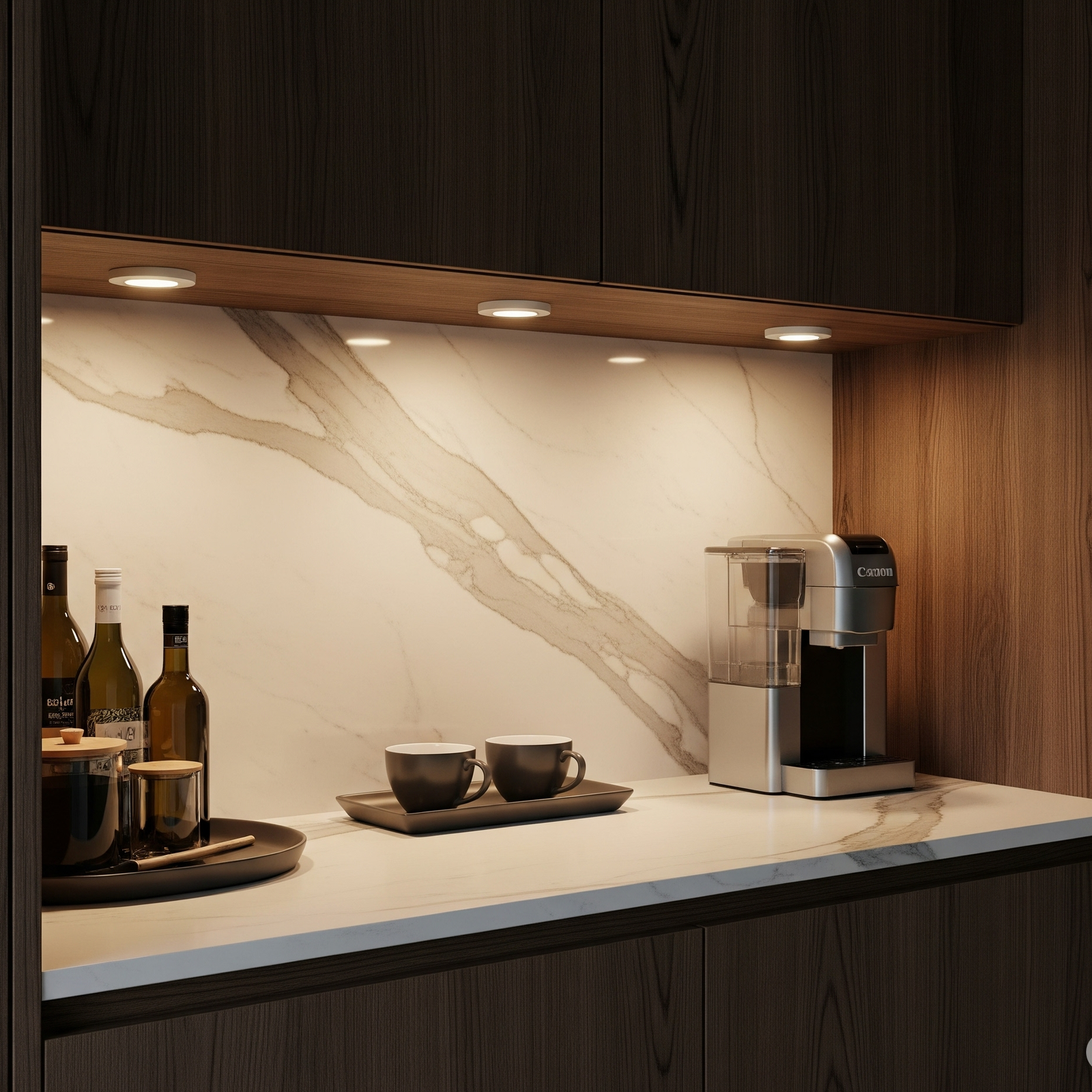
25 Amazing Kitchen Island Lighting Ideas That Will Change Your Space
Here are 25 specific ideas for kitchen island lighting that you can use to get ideas for your next renovation. They are grouped by style and function:
Modern and Contemporary Ideas (1–8)
1. Triple Glass Globe Pendants—Three clear glass spheres with warm Edison bulbs make perfect symmetry over long islands.
2. Oversized Single Drum Pendant—A big, matte black cylindrical shade makes a strong statement over small islands.
3. Geometric Copper Pendants—Brushed copper hexagonal fixtures with angles add warmth to modern kitchens.
4. Linear LED Chandelier: This sleek horizontal fixture has built-in LEDs that spread light evenly.
5. Floating Glass Boxes—These rectangular glass pendants look like they’re floating, which is great for simple designs.
6. Mixed Metal Cluster – Small pendants made of brass, black, and chrome that are all different heights
7. Concrete Cylinder Pendants: These industrial-chic concrete lights add texture to modern spaces.
8. Ribbed Glass Globes—Textured glass balls add interest without breaking up the clean lines.
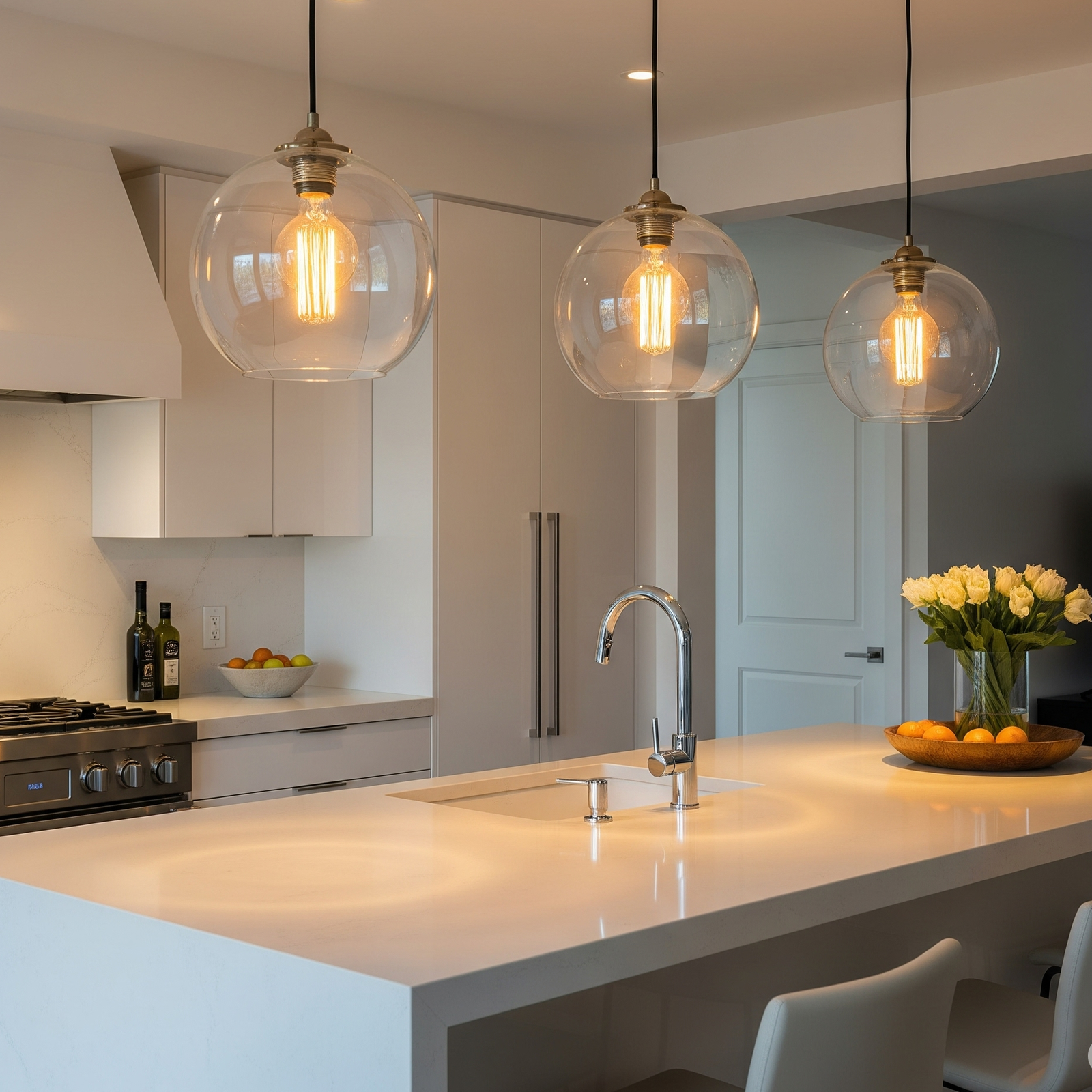
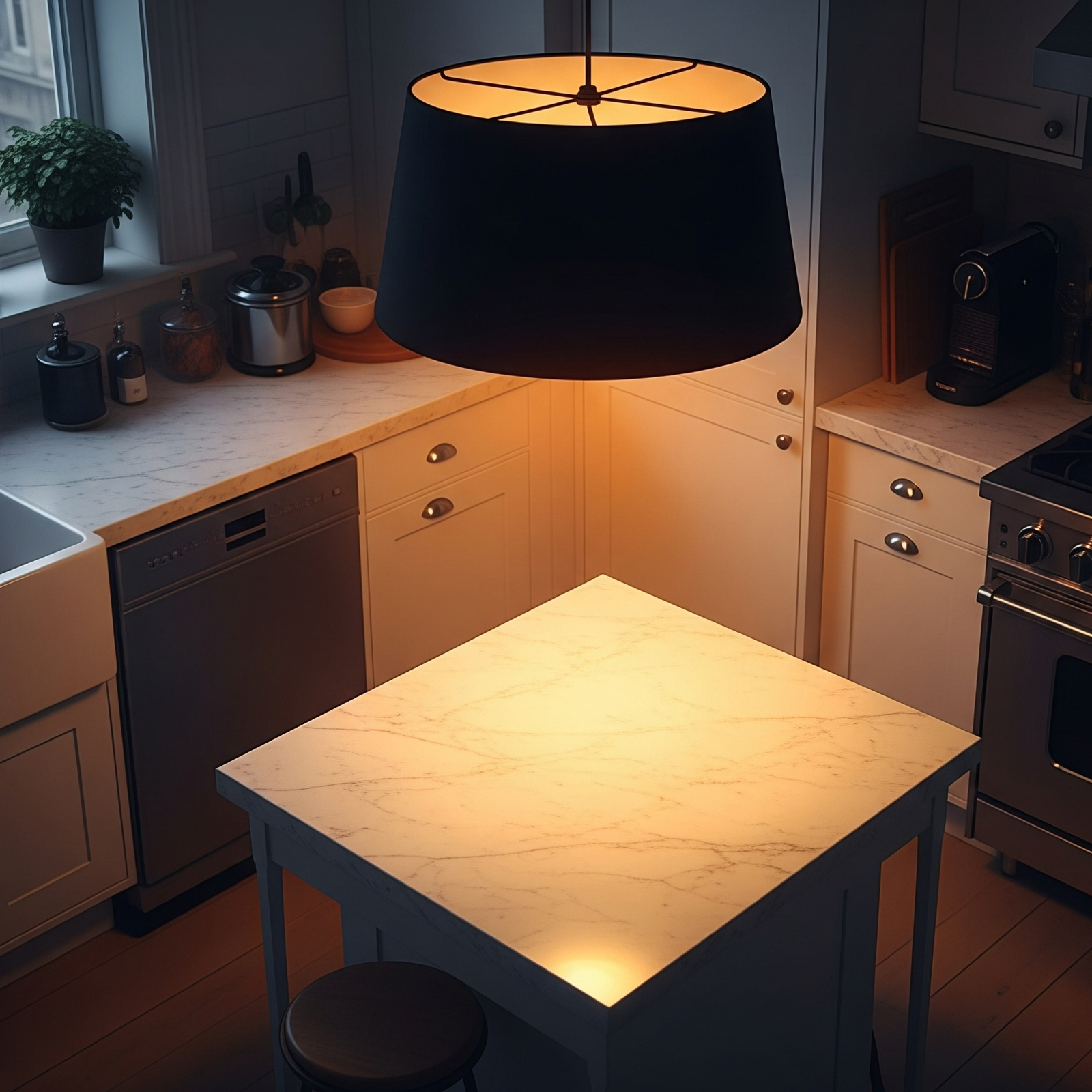
Ideas for Farmhouse and Rustic Styles (9–16)
9. Mason Jar Trio– Custom-made mason jar pendants with chicken wire and Edison bulbs in them
10. Reclaimed Wood Beam Chandelier—A horizontal wood beam with several bulbs hanging from it
11. Black Iron Lanterns – Pendants in the shape of lanterns with clear glass panels
12. Galvanised Metal Shades – Metal cone shades with a weathered finish that look like they came from the past
13. Rope-Wrapped Pendants – Glass lights wrapped in natural jute rope for a coastal farmhouse look
14. Wrought Iron Scrollwork – An ornate iron chandelier with candle-like bulbs
15. Chicken Feeder Lights – Vintage chicken feeders that have been turned into unique pendant shades
16. Wooden Wheel Chandelier – A rustic wagon wheel with Edison bulbs hanging from it
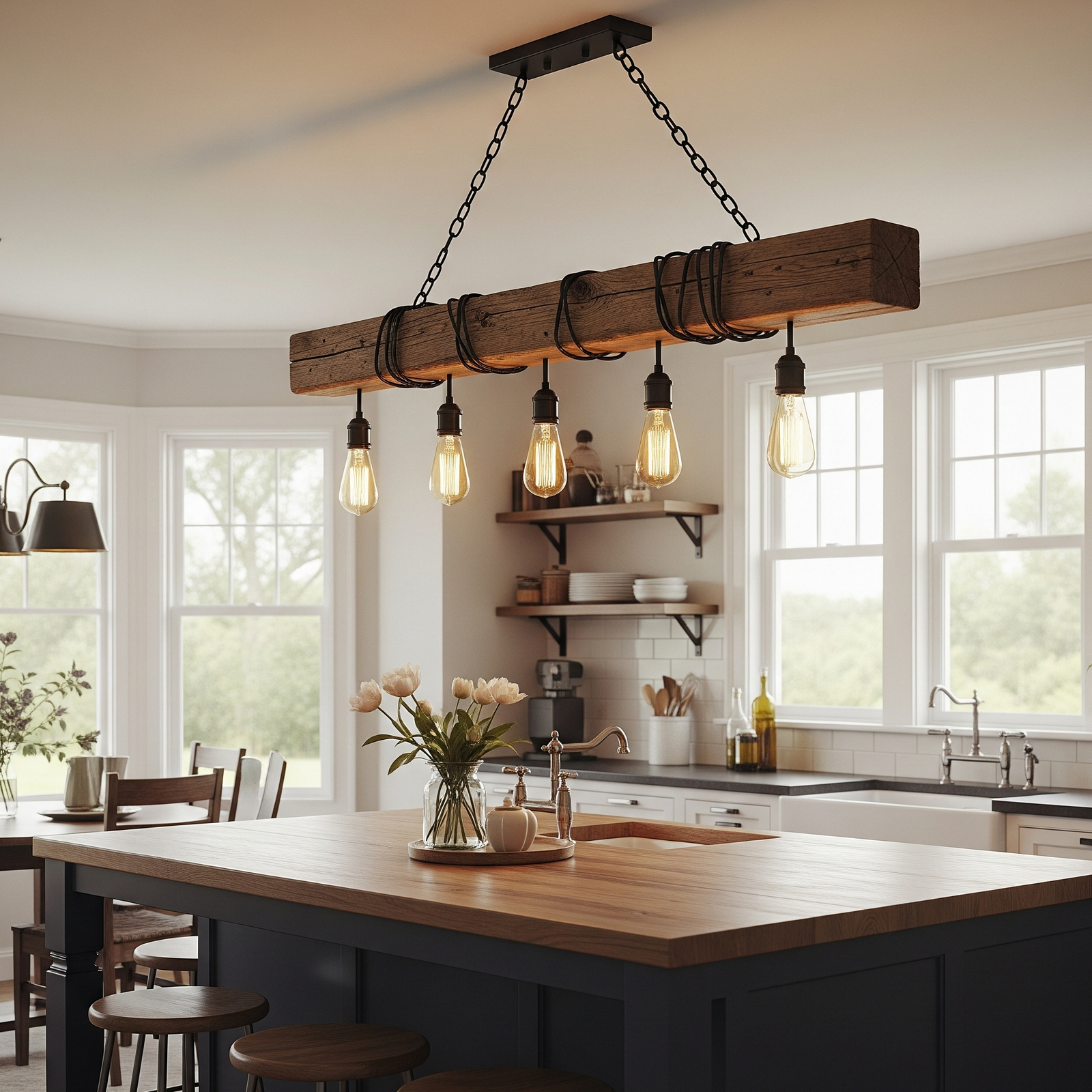
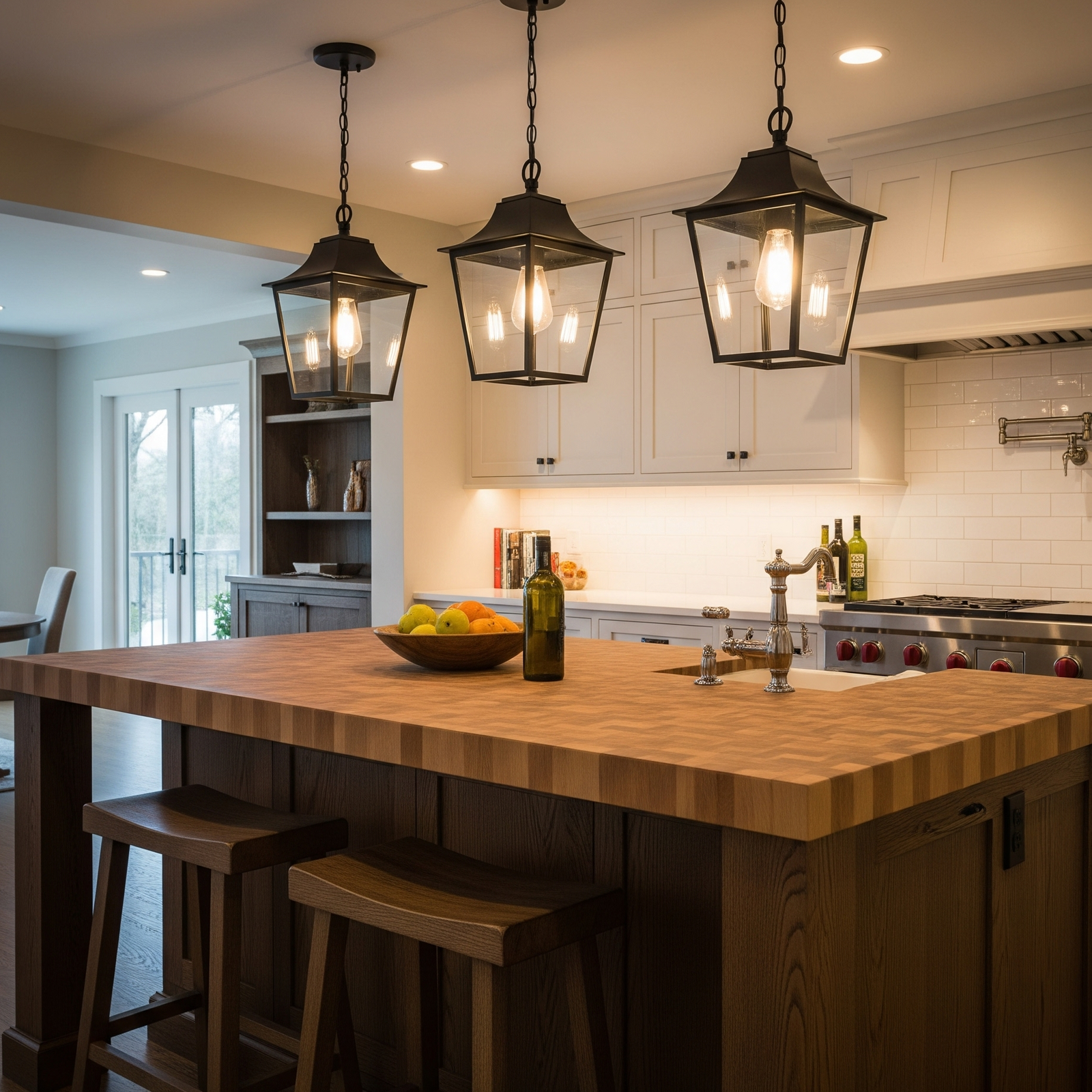
Ideas for the City and Industry (17–21)
17. Metal Cage Pendants – Black-finished wire cage lights with exposed Edison bulbs
18. Vintage Factory Spotlights – Metal spotlights on a track system that can be moved around
19. Pulley System Chandelier: Real pulley hardware with industrial bulbs hanging from it
20. Galvanised Pipe Fixture—A one-of-a-kind chandelier made out of galvanised plumbing pipes
21. Railroad Spike Pendant—A one-of-a-kind piece that uses real railroad spikes
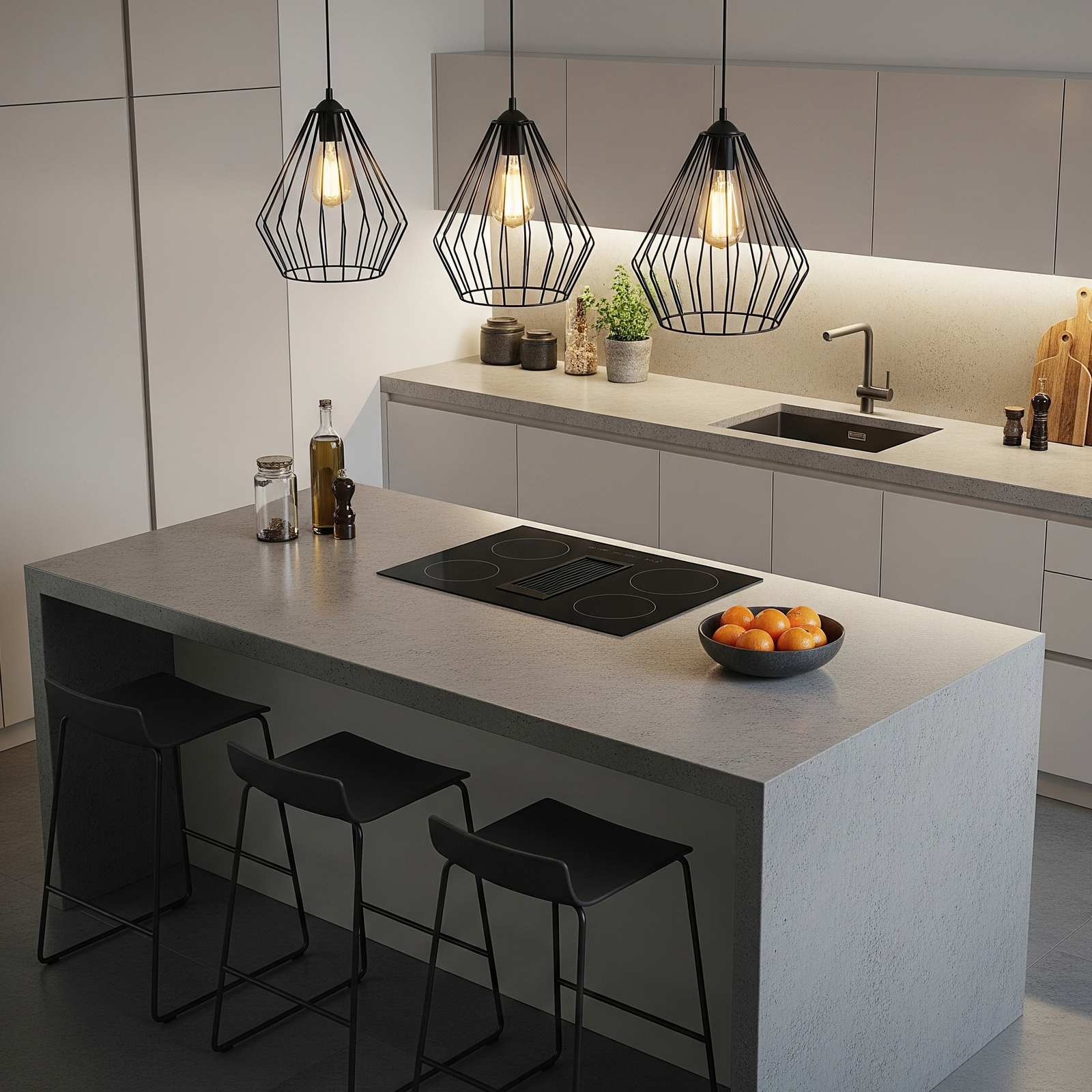
Ideas for the Transition and the Classic (22–25)
22. Fabric Drum Shades – Beautiful drum pendants made of neutral linen with metal trim
23. Crystal Linear Chandelier – A modern take on the classic crystal shape in a linear form
24. Brushed Nickel Globes—a stylish mix of metal and glass in a transitional style
25. Seeded Glass Pendants—Textured glass with a vintage-inspired seeding effect
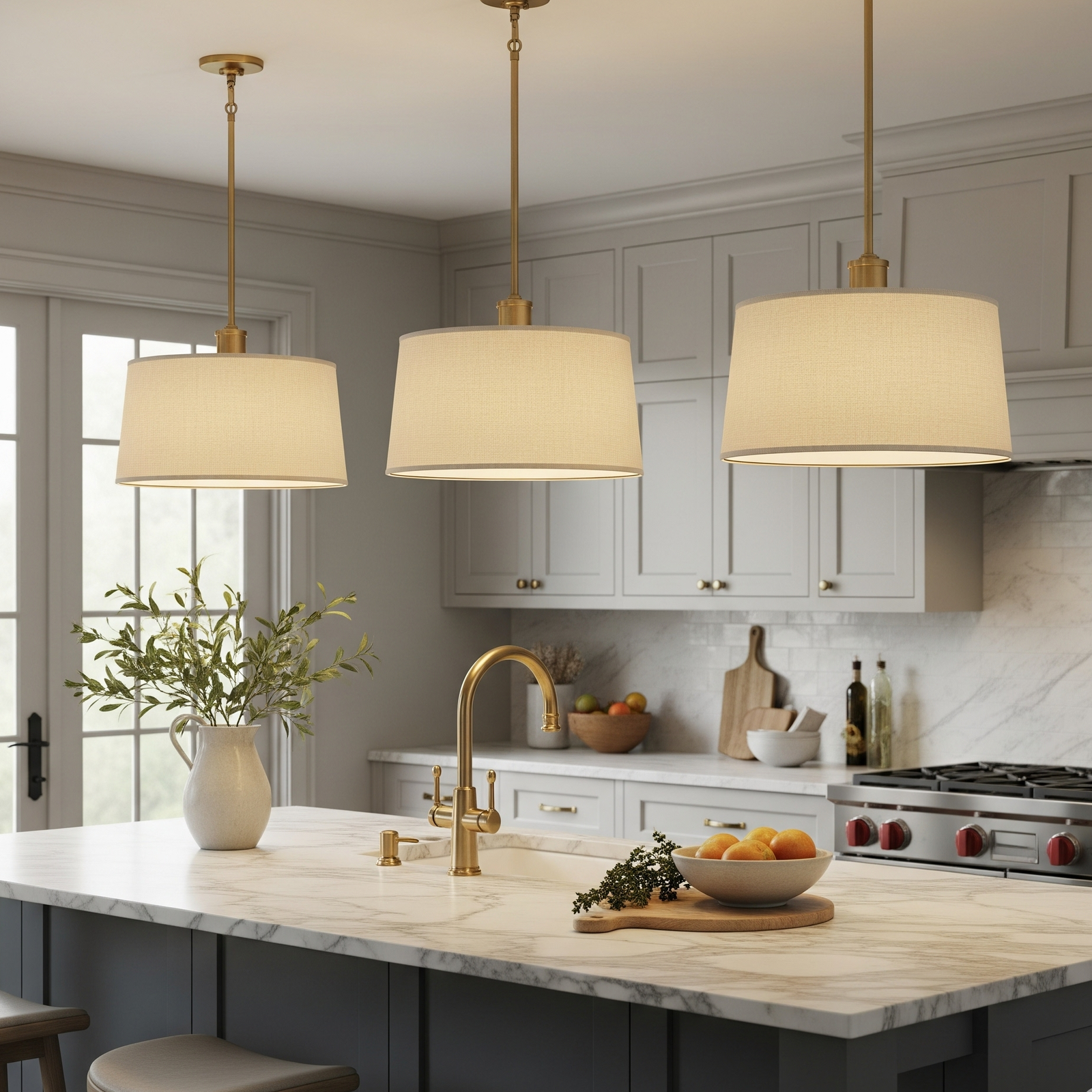
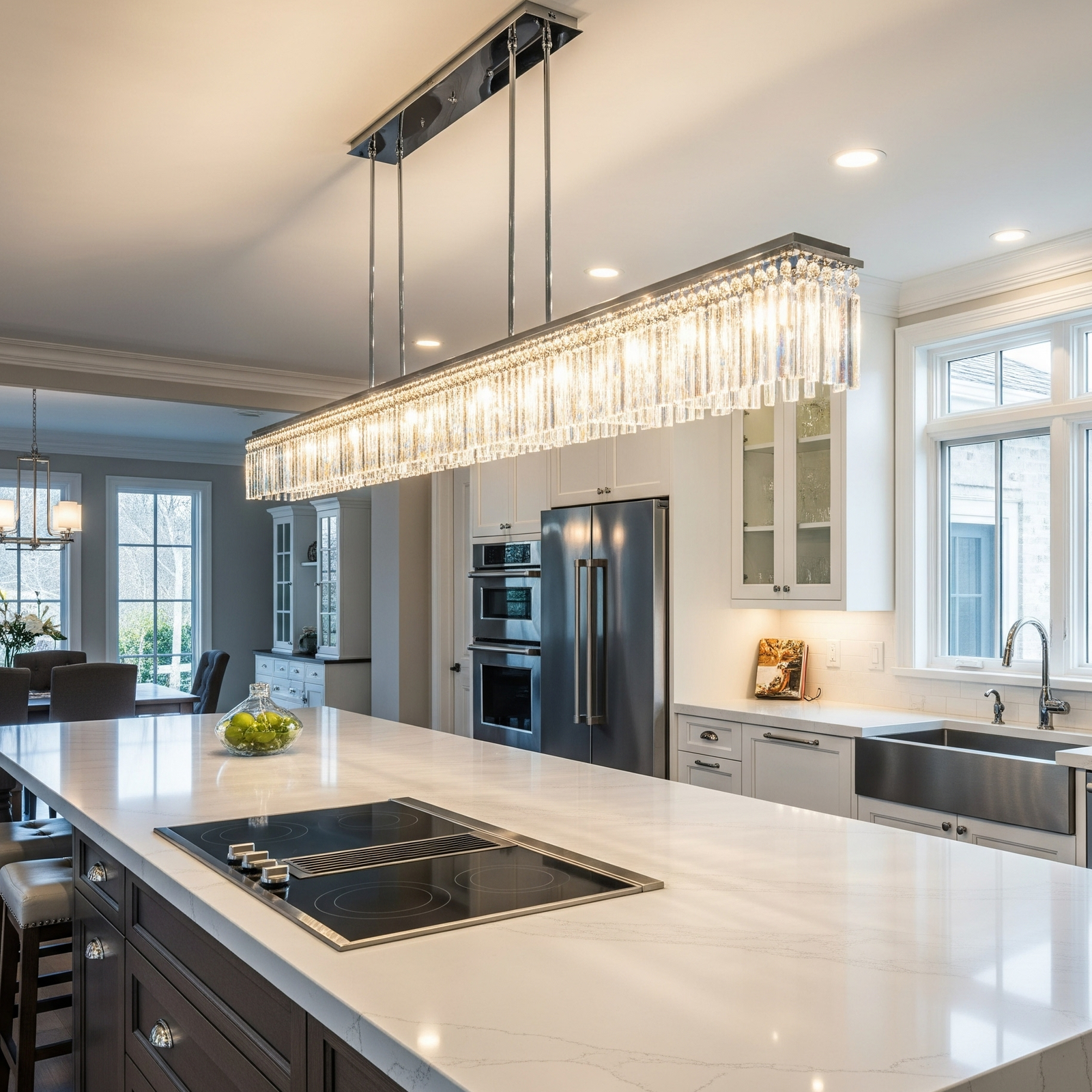
Making a Plan for Your Kitchen Island Lighting Layout
Rules for Measuring and Spacing
If you plan ahead, your kitchen island lighting will look good and work well. First, find out how long and wide your island is and how high your ceiling is. These measurements tell you everything, from the size of the fixtures to the height at which they should be installed.
The height of the ceiling has a big effect on how high things hang. Pendants should usually hang 30 to 32 inches above the island surface in rooms with standard 8-foot ceilings.
Warning Box: Common Mistakes When Taking Measurements
When you measure, don’t forget to include the overhang of your island. The lights should cover the whole work area, not just the area where the base cabinet is. Also, think about seating. The lights should be high enough that guests who are sitting down don’t have to look directly at the bulbs.

Thinking About the Overall Look of Your Kitchen
The lighting for your kitchen island should match the other design and architectural features of the room. Ornate chandeliers or classic pendant styles look best in kitchens with detailed crown molding and traditional cabinets. Sleek, geometric fixtures are needed in modern kitchens with flat-panel cabinets.
It’s also important to match colors. Brass or bronze fixtures will look good in a kitchen with warm wood tones. Stainless steel appliances look great in kitchens with cool colors. Chrome, brushed nickel, or matte black fixtures go well with these kitchens.
Think about how heavy your chosen fixtures will look. Big islands can handle big lighting statements, but small islands need more subtle solutions to keep the space from feeling too busy.
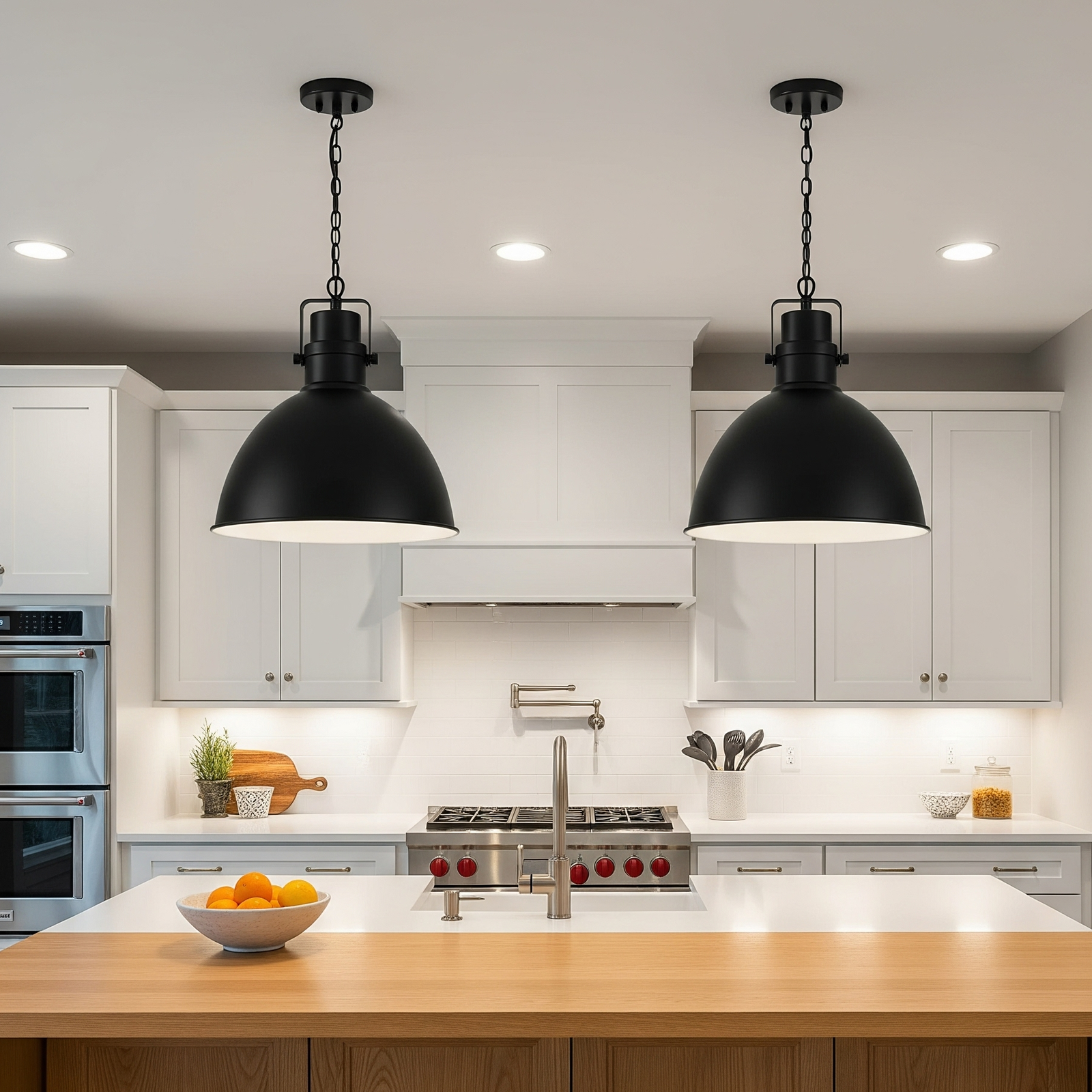
Tips for Installing and Things to Think About as a Professional
DIY vs. Hiring a Pro
A lot of kitchen island lighting projects need electrical work, which means you have to choose between doing it yourself and hiring professionals. Changing out light fixtures on existing electrical boxes is usually something a homeowner can do, but new electrical runs or complicated installations usually need a professional.
Under-cabinet lighting that runs on batteries is easy to install yourself, but hardwired systems usually need an electrician to do it. Before you start any project, think about how skilled you are, what the electrical codes are in your area, and what permits you need.
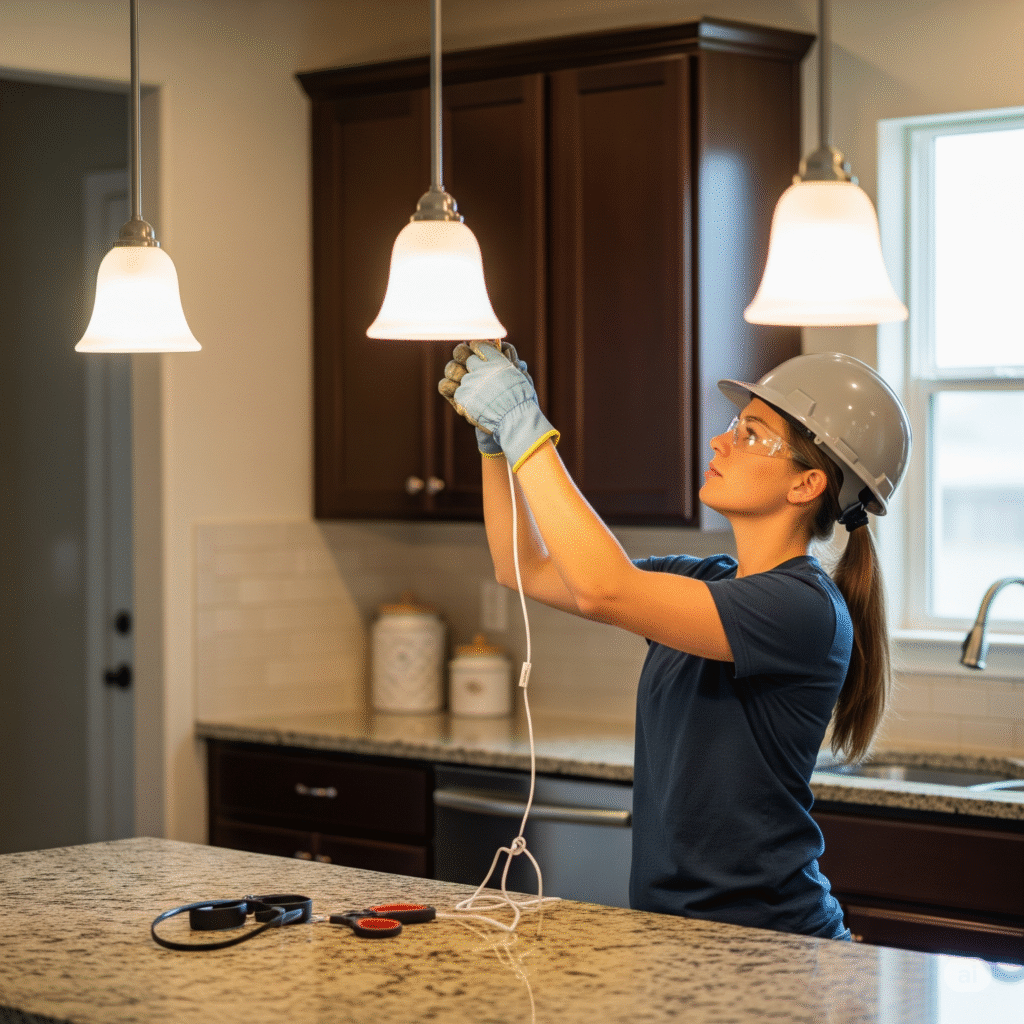
Integration of Smart Lighting
For the best convenience and energy savings, modern kitchen island lighting can work with smart home systems. You can control your lights with your smartphone, voice commands, or automated schedules with smart switches, dimmers, and even smart bulbs.
Think about putting in smart dimmers that can set the lights to different levels for different activities, like bright for cooking, medium for homework, and dim for entertaining. Some systems even change the color temperature during the day to match the body’s natural circadian rhythms.
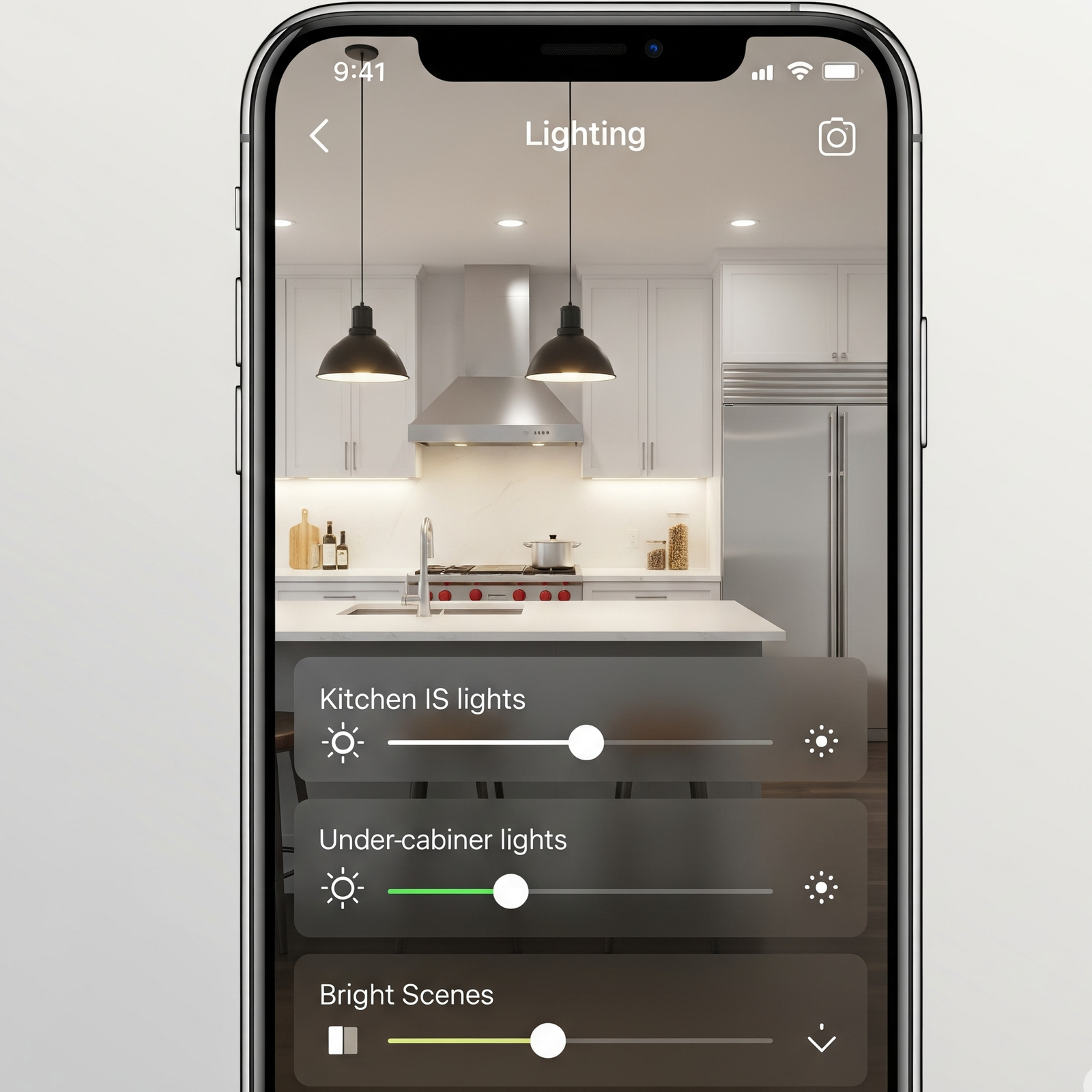
Kitchen Island Lighting Ideas That Won’t Break the Bank
Stylish Choices That Don’t Cost Too Much
You don’t have to spend a lot of money on beautiful kitchen island lighting. There are a lot of stylish options that cost less than $200 per fixture, and you can save even more money by being creative with your DIY projects.
You might want to buy basic pendant lights and then make them your own with spray paint, decorative shades, or special bulbs. You can often find vintage light fixtures at thrift stores and salvage yards that can be rewired and updated for use today.
Battery-powered LED strips are a great value and easy to install for under-cabinet lighting. There are many high-quality choices that cost less than $50 per cabinet section and will last for years.
Tip Box: Ways to Save Money
Look for end-of-season sales at home improvement stores, check online marketplaces for new-in-box fixtures, and think about buying a lot of pendant lights at once to get a better deal. Getting the work area ready and having all the materials ready before the electrician arrives can help lower the cost of installation.
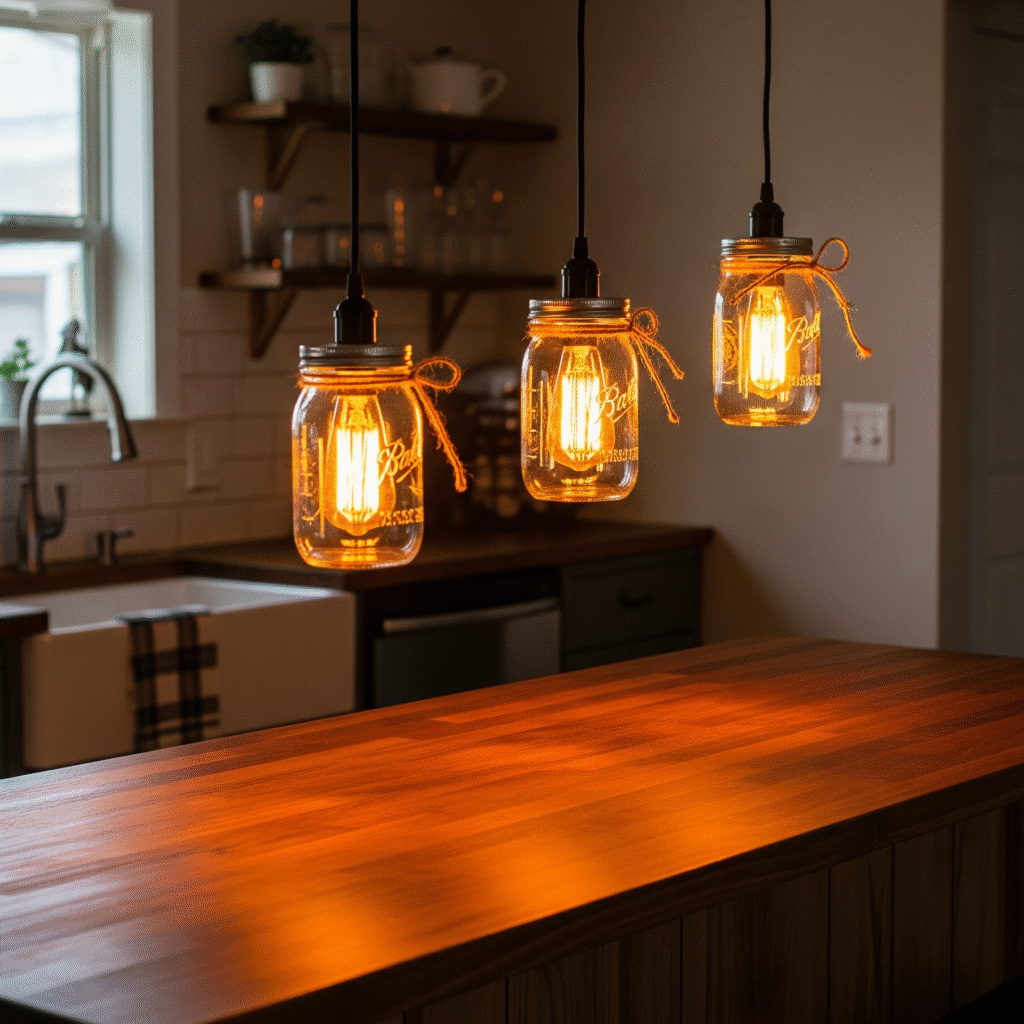
How to Take Care of and Fix Your Kitchen Lighting
How to Keep Your Fixtures Clean and Working
Your kitchen island lighting will look and work better if you take care of it regularly. To avoid damage and get the best light output, you need to take care of different types of fixtures in different ways.
You should clean glass pendants once a week with a glass cleaner that doesn’t leave streaks. This is especially important in kitchens where cooking can leave grease behind. For brass, copper, or other specialty finishes, metal fixtures should be cleaned with mild soap and water and then polished with the right polish.
Under-cabinet lighting doesn’t need to be cleaned as often, but it should be dusted once a month to keep it bright. You can clean LED strips with damp microfiber cloths, but you may need to take the lens off of puck lights to get them really clean.

Common Problems and Easy Fixes
Most problems with kitchen island lighting are easy to fix. Flickering lights are often a sign of loose connections or dimmer switches that don’t work with LED bulbs. When there are problems with dimming, you usually need LED-compatible dimmers instead of regular ones.
Problems with under-cabinet lighting usually have to do with power supply problems or broken connections. If your battery-powered devices don’t work, they might need new batteries.
Warning Box: Safety First
Don’t try to fix electrical problems without the right tools and knowledge. Before doing any work, turn off the circuit breakers. For more complicated problems, call an electrician. Electricity and wet hands don’t mix. Always dry your hands completely before touching switches or other electrical equipment.

Styles that are popular right now and ideas for the future
What Are the Most Popular Kitchen Island Lights Right Now
Natural materials, mixed metals, and big fixtures that make a statement are all popular right now for kitchen island lighting. Rattan and woven pendant shades add a natural feel to modern kitchens, and mixed metal finishes make layered looks that are more elegant.
Hexagonal, triangular, and abstract shapes are taking the place of round pendants, which are still very popular.
Smart kitchen lighting is becoming more common than a luxury. More and more, people expect new installations to have voice control, automatic dimming, and the ability to change colors.

Options that are good for the environment and last a long time
A lot of today’s kitchen island lighting choices are based on being environmentally friendly. Homeowners who care about the environment like fixtures made from recycled materials, reclaimed wood, and metals that are sourced in a way that doesn’t harm the environment.
Solar-powered lights that go under cabinets work in kitchens that get enough light from windows. People who like to live off the grid might like lights that are powered by people (like pedal-powered electricity).
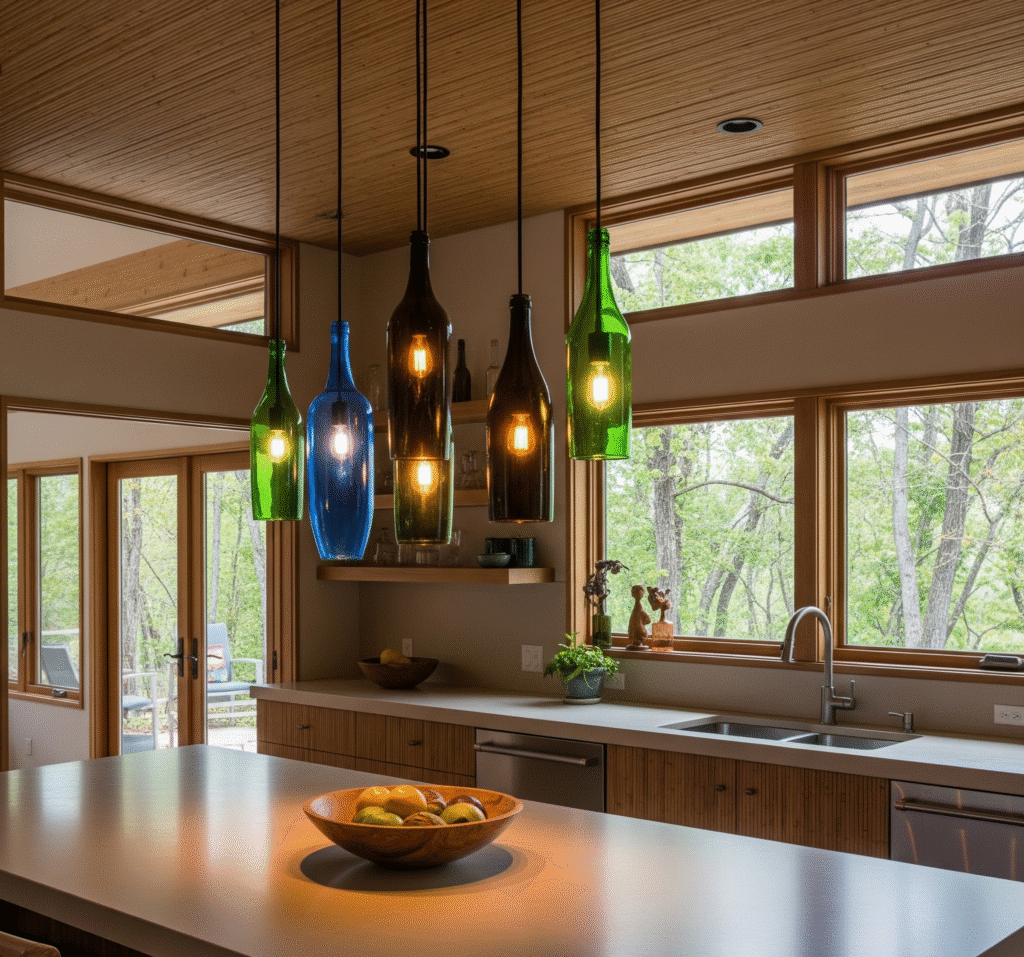
Making the Perfect Layers of Light
Using Different Light Sources Together
The best designs for kitchen island lighting use more than one light source to make light that is flexible and useful. This layered method mixes ambient, task, and accent lighting to make rooms that look great all day long.
Overhead pendant lights or chandeliers are the main source of light for cooking and eating. Under-cabinet lighting is great for doing tasks and also works as ambient lighting at night. Toe-kick lights, glass-front cabinet lights, and decorative sconces all add layers of light that draw attention to architectural details.

RELETED : 30 + Bedroom Wall Color Combinations for Your Dream Space

